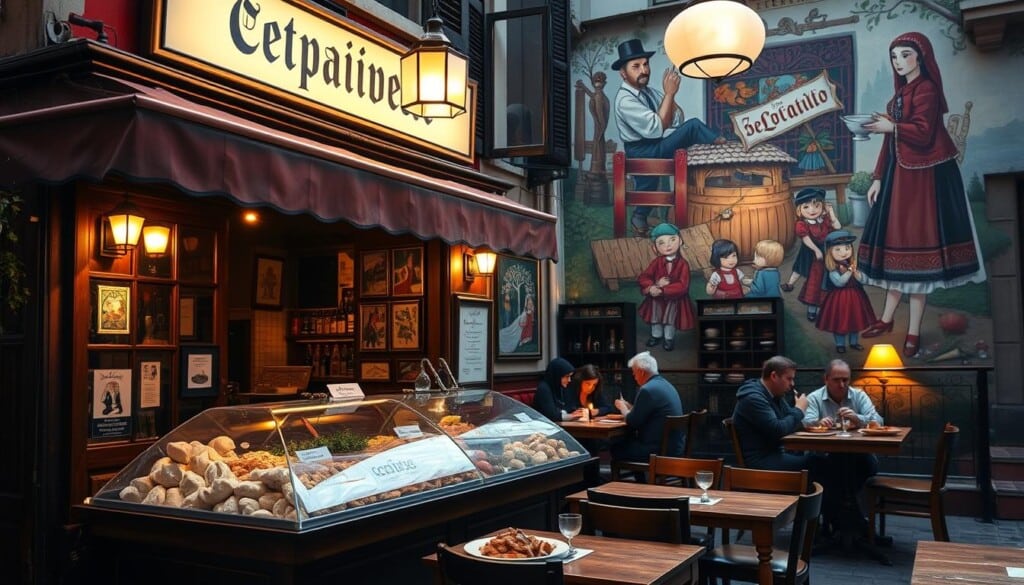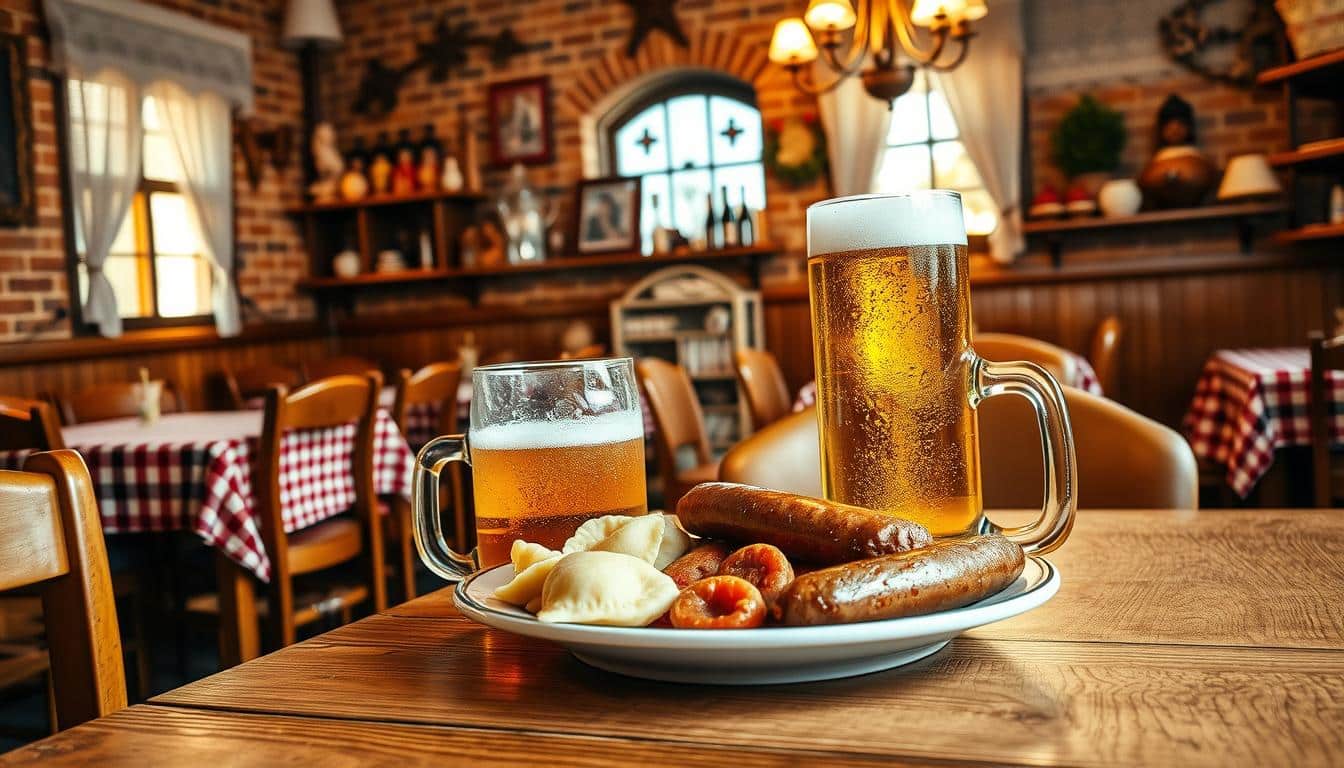Are you ready to explore authentic Polish cuisine? The interest in Polish dishes is rising in the United States. Many people are looking for the best Polish restaurants to try.
These restaurants offer more than just food. They provide a unique Polish dining experience. This experience is filled with history and tradition. We will look at the top places to enjoy Polish food. You’ll learn about regional specialties and how Polish-American culture influences these dishes.
Key Takeaways
- The growing popularity of Polish food reflects a nation discovering its culinary roots.
- Traditional Polish dishes showcase a blend of cultural influences and local ingredients.
- Finding top Polish restaurants can enhance your dining experience significantly.
- Regional variations in Polish cuisine add excitement to the dining scene.
- Exploring Polish food opens pathways to understanding a rich cultural heritage.
Discovering the Rich Flavors of Polish Cuisine
Authentic Polish cuisine is a mix of history and culture. It has been shaped by many historical events. This has brought together flavors from Germany and Russia, making Polish food a unique adventure for food lovers.
Historical Influences on Polish Food
Polish cuisine has changed over the years, thanks to trade and migration. Its history with neighboring cultures has added many flavors and techniques. This blend makes Polish food what it is today.
Common Ingredients in Polish Dishes
Popular Polish dishes often feature potatoes, cabbage, and meats. These ingredients are the base for many recipes. They add to the taste and texture of Polish dishes, making them hearty and flavorful.
Popular Polish Dishes You Must Try
Don’t miss out on pierogi, borscht, and kielbasa. Each dish tells a story of Polish heritage. They offer a mix of savory and sweet flavors, showing the rich side of Polish cuisine.
Must-Visit Polish Food Restaurants by Region
Exploring Polish cuisine across different regions shows a rich variety of flavors and traditions. Each area has its own unique dishes and culinary styles. Whether you’re looking for top Polish restaurants or a local spot, there’s something for everyone.
Northeast US: Taste of Tradition
The Northeast is known for its authentic Polish food experiences in the United States. Places like Pierozek in Greenpoint, NYC, focus on handmade pierogi and traditional recipes. It’s a great place to try Polish comfort food.
Midwest: Heart of Polish Cuisine
The Midwest is at the heart of Polish cuisine, celebrating its roots with comforting dishes. Top Polish restaurants here serve classics like bigos and kielbasa. It’s a place where hearty meals and authentic flavors come together.
West Coast: Modern Takes on Classics
The West Coast offers a fresh take on Polish cuisine, with chefs using local ingredients and new techniques. Restaurants here create modern versions of traditional dishes. It’s a great spot for those looking for exciting new flavors.

How to Find the Best Polish Food Restaurants
Finding the top Polish food spots can make your dining experience better. LocalZ makes it easy to find real Polish food that fits your taste. You can look through listings to see what’s near you.
Using LocalZ for Your Search
LocalZ is a great place to find Polish restaurants. You can search for the best pierogi and other favorites. The site is easy to use, showing you details like location, menu, and reviews.
Factors to Consider When Choosing a Restaurant
When picking a Polish restaurant, think about the menu, atmosphere, and community. A place that sticks to traditional recipes offers a true Polish taste. Also, the vibe of the restaurant should match what you like.
Reading Reviews and Ratings
Reading reviews of Polish restaurants is very helpful. They tell you about the food, service, and overall experience. A restaurant’s ratings can help you choose the best place for pierogi and other Polish dishes.
Top Five Polish Food Restaurants in the USA
In the USA, a few places stand out for their authentic Polish food. Each spot on this list offers unique dishes and specialties. They mix traditional recipes with a modern twist. This creates a rich tapestry of flavors that show the true spirit of Polish cooking.

Regionally Celebrated Establishments
Every region in the USA has its own Polish food scene. From Chicago’s busy streets to New York’s quiet corners, these places are known for their commitment to Polish dishes. They focus on heritage and quality, making every bite special.
Unique Dishes and Specialties
These top Polish restaurants are famous for their unique dishes. For example, Pierozek’s potato and cheese pierogi offer a traditional taste that’s hard to find. They also have innovative menu items that mix classic flavors with new techniques. This appeals to both those who love traditional food and those who prefer something new.
Customer Favorites and Signature Items
Customer favorites often include signature items that make each restaurant unique. Polish restaurant reviews often mention dishes like bigos (hunter’s stew) or babka. These dishes not only satisfy but also create lasting memories. They make people want to come back for more.
LocalZ: Connecting You to Polish Food Restaurants
LocalZ is a platform that helps you find authentic Polish food near you. It uses a simple search system to show you Polish restaurants in your area. This makes it easier to enjoy local dining and connect with the community.
What is LocalZ and How Does it Work?
LocalZ is a tool that makes finding Polish food easy. Just enter your location to see a list of nearby restaurants. You can check menus, hours, and contact info easily, helping you decide where to go.
Benefits of Using LocalZ for Dining Out
Using LocalZ means you can easily find real Polish food and support local businesses. It helps the local economy and gives you a chance to try different foods. The platform’s filters make it simple to find what you like, making your dining experience better.
Community Engagement Through LocalZ
LocalZ is key in building community spirit by helping local businesses grow. It works with groups to support Polish food places. This makes sure the community’s needs come first.

Supporting Local Businesses
LocalZ mainly focuses on helping Polish restaurants and food sellers. It makes an online directory to help them get noticed. This helps the local economy grow as people choose to eat at local spots.
Giving Back: Fundraising Through Listings
LocalZ also helps by giving some of its money to community causes. This shows it cares about the community. It helps businesses help out while promoting their services.
Partnering with Community Affiliates
LocalZ teams up with local groups to make a bigger difference. This partnership helps Polish businesses more. Together, they improve the community and celebrate Polish culture.
Booking a Table Made Easy
Finding the perfect spot for a Polish meal is now easier with LocalZ. Users can look through Polish restaurant listings and book directly on the platform. This makes planning meals simpler and ensures a great time without delays.
Making Reservations Directly Through Listings
LocalZ lets users check the latest on restaurant availability. By picking a date and time, diners can book their table ahead. Getting instant confirmation makes it perfect for those looking for Polish food nearby. This system makes dining out smooth and enjoyable, without the wait.
Walk-In vs. Reservation: When to Choose
Choosing between walking in or booking a table depends on several things. Reservations are best for busy times at popular spots, cutting down wait times. Walk-ins might be better for off-peak hours or for those who want to go spontaneously. Knowing when to use each option can enhance your dining experience, fitting your schedule and preferences.
Exploring Polish Culture Through Food
Food is key in Polish culture, connecting tradition and community. Polish festivals celebrate the country’s rich food heritage. Traditional dishes like Pierogi and Bigos show the heart of Polish identity.
These meals bring people together, creating joy and unity. Sharing these food experiences during festivals shows food’s role in uniting people.
Cooking classes offer a hands-on way to learn. They teach authentic recipes and cooking methods passed down through generations. Culinary tours also explore regional specialties and their cultural backgrounds.
These tours offer a deep dive into Polish cuisine. They make learning about food both fun and educational. To find cooking classes and culinary tours, check out this directory.
Engaging with Local Polish Communities
Exploring local Polish communities adds depth to your dining experience. Food enthusiasts events like festivals and pop-up dinners are great for this. They bring people together to celebrate Polish cuisine and share cooking tips.
Events and Meetups for Food Enthuasiasts
Workshops on making pierogi and traditional supper clubs are unique experiences. They let you learn about Polish cooking techniques and ingredients. Local Polish communities host many events throughout the year, focusing on different dishes and encouraging people to meet and share their love for food.
Celebrating Polish Heritage Through Cuisine
Food is a powerful way to express Polish heritage and appreciate culinary arts. Events like Wigilia or the Feast of St. Andrew celebrate traditional Polish holidays. These events help keep Polish traditions alive, connecting generations and welcoming everyone to experience Polish culture through food.

